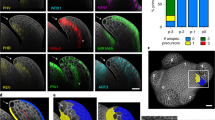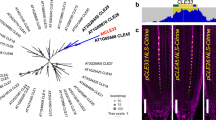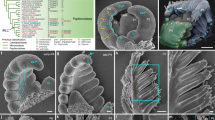Abstract
The upper side of the angiosperm leaf is specialized for efficient capture of sunlight whereas the lower side is specialized for gas exchange. In Arabidopsis, the establishment of polarity in the leaf probably requires the generation and perception of positional information along the radial (adaxial versus abaxial or central versus peripheral) dimension of the plant. This is because the future upper (adaxial) side of the leaf develops from cells closer to the centre of the shoot, whereas the future under (abaxial) side develops from cells located more peripherally. Here we implicate the Arabidopsis PHABULOSA and PHAVOLUTA genes in the perception of radial positional information in the leaf primordium. Dominant phabulosa (phb)1 and phavoluta (phv) mutations cause a dramatic transformation of abaxial leaf fates into adaxial leaf fates. They do so by altering the predicted sterol/lipid-binding domains of ATHB14 and ATHB9, proteins of previously unknown function that also contain DNA-binding motifs. This change probably renders the protein constitutively active, implicating this domain as a central regulator of protein function and the PHB and PHV proteins as receptors for an adaxializing signal.
This is a preview of subscription content, access via your institution
Access options
Subscribe to this journal
Receive 51 print issues and online access
$199.00 per year
only $3.90 per issue
Buy this article
- Purchase on Springer Link
- Instant access to full article PDF
Prices may be subject to local taxes which are calculated during checkout




Similar content being viewed by others
References
McConnell, J. R. & Barton, M. K. Leaf polarity and meristem formation in Arabidopsis. Development 125, 2935–2942 (1998).
Sessa, G., Steindler, C., Morelli, G. & Roberti, I. The Arabidopsis Athb-8, -9 and -14 genes are members of a small gene family coding for highly related HD-ZIP proteins. Plant Mol. Biol. 38, 609–622 (1998).
Zhong, R. & Ye, Z.-Y. IFL1, a gene regulating interfascicular fiber differentiation in Arabidopsis, encodes a homeodomain-leucine zipper protein. Plant Cell 11, 2139–2152 (1999).
Ratcliffe, O. J., Riechmann, J. L. & Zhang, J. Z. INTERFASCICULAR FIBERLESS1 is the same gene as REVOLUTA. Plant Cell 12, 315–317 (2000).
Talbert, P., Adler, H. T., Parks, D. W. & Comai, L. The REVOLUTA gene is necessary for apical meristem development and for limiting cell divisions in the leaves and stems. Development 121, 2723–2735 (1995).
Ponting, C. P. & Aravind, L. START: a lipid-binding domain in StAR, HD-ZIP and signalling proteins. Trends Biochem. Sci. 24, 130–132 (1999).
Lynn, K. et al. The PINHEAD/ZWILLE gene acts pleiotropically in Arabidopsis development and has overlapping functions with the ARGONAUTE1 gene. Development 126, 469–481 (1999).
Sawa, S. et al.FILAMENTOUS FLOWER, a meristem and organ identity gene of Arabidopsis, encodes a protein with a zinc finger and HMG-related domains. Genes Dev. 13, 1079–1088 (1999).
Siegfried, K. R. et al. Members of the YABBY gene family specify abaxial cell fate in Arabidopsis. Development 126, 4117–4128 (1999).
Sussex, I. M. Morphogenesis in Solanum tuberosum L: experimental investigation of leaf dorsiventrality and orientation in the juvenile shoot. Phytomorphology 5, 286–300 (1955).
Snow, M. & Snow, R. The dorsiventrality of leaf primordia. New Phytol. 8, 188–207 (1959).
Benfey, P. N., Ren, L. & Chua, N. H. Tissue-specific expression from CaMV 35S enhancer subdomains in early stages of plant development. EMBO J. 9, 1677–1684 (1990).
Clough, S. J. & Bent, A. F. Floral dip: a simplified method for Agrobacterium-mediated transformation of Arabidopsis thaliana. Plant J. 16, 735–743 (1998).
Long, J. A. & Barton, M. K. Initiation of axillary and floral meristems in Arabidopsis. Dev. Biol. 125, 341–353 (2000).
Waites, R. & Hudson, A. phantastica: a gene required for dorsoventrality of leaves in Antirrhinum majus. Development 121, 2143–2154 (1995).
Acknowledgements
We would like to thank M. Evans and K. Lynn for comments on the manuscript and A. Hamilton, A. Derr and B. Bordini for technical assistance. This work was supported by grants from the Beckman Foundation, NSF and the USDA.
Author information
Authors and Affiliations
Corresponding author
Rights and permissions
About this article
Cite this article
McConnell, J., Emery, J., Eshed, Y. et al. Role of PHABULOSA and PHAVOLUTA in determining radial patterning in shoots. Nature 411, 709–713 (2001). https://doi.org/10.1038/35079635
Received:
Accepted:
Published:
Issue Date:
DOI: https://doi.org/10.1038/35079635
This article is cited by
-
GhHB14_D10 and GhREV_D5, two HD-ZIP III transcription factors, play a regulatory role in cotton fiber secondary cell wall biosynthesis
Plant Cell Reports (2024)
-
microRNA165 and 166 modulate response of the Arabidopsis root apical meristem to salt stress
Communications Biology (2023)
-
Conserved and non-conserved RNA–target modules in plants: lessons for a better understanding of Marchantia development
Plant Molecular Biology (2023)
-
Genome-Wide Analysis of YABBY Gene Family in Lettuce (Lactuca sativa) and Functional Characterization of LsaFILd
Journal of Plant Growth Regulation (2023)
-
Differential gene expression analysis of the resprouting process in Pinus canariensis provides new insights into a rare trait in conifers
Plant Growth Regulation (2023)
Comments
By submitting a comment you agree to abide by our Terms and Community Guidelines. If you find something abusive or that does not comply with our terms or guidelines please flag it as inappropriate.



